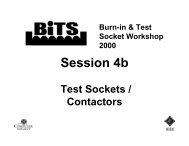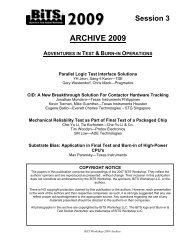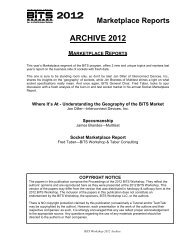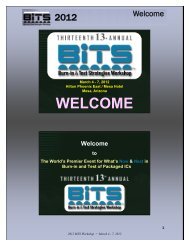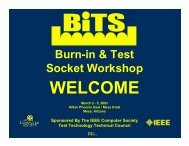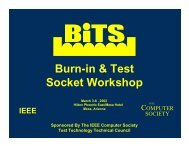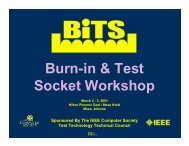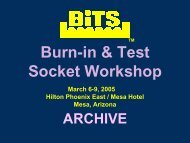ESD - BiTS Workshop
ESD - BiTS Workshop
ESD - BiTS Workshop
You also want an ePaper? Increase the reach of your titles
YUMPU automatically turns print PDFs into web optimized ePapers that Google loves.
Burn-in & Test<br />
Socket <strong>Workshop</strong><br />
March 6-9, 2005<br />
Hilton Phoenix East / Mesa Hotel<br />
Mesa, Arizona<br />
ARCHIVE<br />
TM
Burn-in & Test Socket<br />
<strong>Workshop</strong><br />
TM<br />
COPYRIGHT NOTICE<br />
• The papers in this publication comprise the proceedings of the 2005<br />
<strong>BiTS</strong> <strong>Workshop</strong>. They reflect the authors’ opinions and are reproduced<br />
as presented , without change. Their inclusion in this publication does<br />
not constitute an endorsement by the <strong>BiTS</strong> <strong>Workshop</strong>, the sponsors,<br />
<strong>BiTS</strong> <strong>Workshop</strong> LLC, or the authors.<br />
• There is NO copyright protection claimed by this publication or the<br />
authors. However, each presentation is the work of the authors and<br />
their respective companies: as such, it is strongly suggested that any<br />
use reflect proper acknowledgement to the appropriate source. Any<br />
questions regarding the use of any materials presented should be<br />
directed to the author/s or their companies.<br />
• The <strong>BiTS</strong> logo and ‘Burn-in & Test Socket <strong>Workshop</strong>’ are trademarks<br />
of <strong>BiTS</strong> <strong>Workshop</strong> LLC.
tm<br />
Burn-in & Test<br />
Socket <strong>Workshop</strong><br />
Hot Topics Session<br />
Tuesday 3/08/05 3:30PM<br />
CONTROLLING <strong>ESD</strong><br />
Technical Program<br />
“Methods Of Preventing <strong>ESD</strong> In Module Testing”<br />
Zen Podpora – IBM Microelectronics<br />
Qifang (Michelle) Qiao – IBM Microelectronics Patrick Rafter – IBM Microelectronics<br />
“New <strong>ESD</strong> Control Polymers”<br />
Naomitsu Nishihata – Kureha Chemical Industry Co., Ltd.
METHODS OF<br />
PREVENTING <strong>ESD</strong> IN<br />
MODULE TESTING<br />
2005 Burn-in and Test Socket <strong>Workshop</strong><br />
Zen Podpora<br />
Michelle Qiao<br />
Patrick Rafter<br />
Contacting Systems Engineering<br />
IBM Microelectronics
Objectives<br />
• <strong>ESD</strong> overview<br />
• Impact of <strong>ESD</strong> on module test<br />
• Methods of <strong>ESD</strong> prevention<br />
BITS 2005<br />
Methods of preventing <strong>ESD</strong> in<br />
module testing.<br />
2
Agenda<br />
• What is static electricity<br />
• Causes of static charge buildup<br />
• Impact of <strong>ESD</strong> on product and test<br />
equipment<br />
• Conventional <strong>ESD</strong> prevention methods and<br />
their deficiencies<br />
• IBM <strong>ESD</strong> socket design<br />
BITS 2005<br />
Methods of preventing <strong>ESD</strong> in<br />
module testing.<br />
3
What is Static Electricity?<br />
• Simply electricity at rest<br />
– No current flowing<br />
• Surface phenomenon<br />
– Static charge is dependent on surface area<br />
• Coulomb's law; F = k (Q 1 X Q 2 ) / d 2<br />
– Electric force between charges at rest<br />
BITS 2005<br />
Methods of preventing <strong>ESD</strong> in<br />
module testing.<br />
4
Static Charge Buildup<br />
• Electric<br />
phenomenon in<br />
which intimate<br />
contact transfers<br />
charged particles<br />
from one body to<br />
another<br />
Rubbing two non conducting materials together<br />
BITS 2005<br />
Methods of preventing <strong>ESD</strong> in<br />
module testing.<br />
5
Static Charge Buildup<br />
• Only insulative materials build up static<br />
charge<br />
– Insulative material surface resistivity<br />
> 10 12 ohms / sq<br />
• Socket components comprise insulative<br />
materials<br />
– Static charge build up from module insertion into<br />
socket<br />
BITS 2005<br />
Methods of preventing <strong>ESD</strong> in<br />
module testing.<br />
6
Static Charge Buildup in Socket<br />
insulator<br />
Electrostatic charge build up during module insertion<br />
BITS 2005<br />
Methods of preventing <strong>ESD</strong> in<br />
module testing.<br />
7
Electrostatic Discharge [<strong>ESD</strong>]<br />
• Common <strong>ESD</strong><br />
events<br />
– Lightning<br />
– Walk across the rug<br />
and reach doorknob<br />
• Module test events<br />
– Charged operator<br />
reaching IC module<br />
– Charged socket<br />
discharging thru the<br />
tester<br />
Discharge of build up<br />
of static electricity<br />
BITS 2005<br />
Methods of preventing <strong>ESD</strong> in<br />
module testing.<br />
8
Common Causes of <strong>ESD</strong> Damage<br />
• Human Body Model (HBM) 99.9%<br />
– <strong>ESD</strong>S transportation<br />
– Air blow-off operations<br />
– IC handling equipment<br />
BITS 2005<br />
Methods of preventing <strong>ESD</strong> in<br />
module testing.<br />
9
Impact of <strong>ESD</strong><br />
• Electrostatic Discharge (<strong>ESD</strong>) destroys<br />
electronic hardware<br />
– Immediate failures - distractive damage<br />
• Direct-current resulting in junction burnout,<br />
shorts, dielectric breakdown, and metallization<br />
melt<br />
– Latent failures (field failures), days, weeks,<br />
months later<br />
• <strong>ESD</strong> creates problems which cost industry<br />
billions of dollars per year<br />
BITS 2005<br />
Methods of preventing <strong>ESD</strong> in<br />
module testing.<br />
10
Conventional <strong>ESD</strong> Prevention<br />
• Grounding<br />
– Personnel<br />
– Equipment<br />
• Ionization<br />
– Ionizing units neutralize charged particles<br />
• Use of resistive materials<br />
– Surface resistivity 10 6 10 9 ohms (carbon mix)<br />
• Humidity control<br />
– Relative humidity greater than 50% will minimize<br />
<strong>ESD</strong> problems<br />
BITS 2005<br />
Methods of preventing <strong>ESD</strong> in<br />
module testing.<br />
11
Problems with Conventional <strong>ESD</strong><br />
Prevention<br />
• Resistive materials<br />
• Non uniform carbon distribution (hot pockets)<br />
• Leakage currents<br />
• Humidity control<br />
• Condensation problem at low temp test<br />
• Grounding<br />
• Operators bypass <strong>ESD</strong> procedures<br />
BITS 2005<br />
Methods of preventing <strong>ESD</strong> in<br />
module testing.<br />
12
IBM <strong>ESD</strong> Socket<br />
conductor<br />
insulator<br />
No static charge buildup at module insertion<br />
BITS 2005<br />
Methods of preventing <strong>ESD</strong> in<br />
module testing.<br />
13
IBM <strong>ESD</strong> Socket<br />
• Alignment plate frame<br />
– Made from<br />
conductive material<br />
[< 10 4 ohms/sq]<br />
– Will not store electric<br />
charge<br />
• Alignment plate grid<br />
– Made from insulative<br />
material<br />
[> 10 12 ohms/sq]<br />
– Will not cause<br />
leakage currents<br />
conductor<br />
insulator<br />
BITS 2005<br />
Methods of preventing <strong>ESD</strong> in<br />
module testing.<br />
14
<strong>ESD</strong> Facts<br />
• CMOS chips damage as little as 50V<br />
• If you feel a ‘shock’ at least 3kV<br />
• Walking across a carpet 1.5kV to 35kV<br />
• Brushing your hair 1.2kV to 27kV<br />
• Not getting ZAPPED priceless<br />
BITS 2005<br />
Methods of preventing <strong>ESD</strong> in<br />
module testing.<br />
15
Reference Materials<br />
• Basics of Static Electricity by Ron Kurtus (revised 28 August 2004<br />
– www.school-for-champions.com<br />
• The Most Common Causes Of <strong>ESD</strong> Damage by Roger J.<br />
Peirce, <strong>ESD</strong> Technical Services<br />
– http://www.evaluationengineering.com/default.asp<br />
• WHAT IS STATIC ELECTRICITY? by SCIENCE MADE SIMPLE<br />
– http://www.sciencemadesimple.com/index.html<br />
• What is <strong>ESD</strong> ? By Research Machines plc<br />
– http://www.rm.com/<br />
• <strong>ESD</strong> Is Shocking Experience for Electronics by Ron Brewer,<br />
Instrument Specialties, P.O. Box 650, Delaware Water Gap, PA 18327, (570) 424-8510.<br />
BITS 2005<br />
Methods of preventing <strong>ESD</strong> in<br />
module testing.<br />
16
New <strong>ESD</strong> Control Polymers<br />
Naomitsu Nishihata<br />
Kureha Chemical Industry Co., Ltd.<br />
Burn-in & Test<br />
Socket <strong>Workshop</strong><br />
TM<br />
2005 Burn-in and Test Socket <strong>Workshop</strong><br />
March 6 - 9, 2005
Agenda<br />
• What is <strong>ESD</strong><br />
• Material for socket<br />
• Technology review<br />
• New technology<br />
• Sample preparation<br />
• Characterization<br />
• Conclusion<br />
11/12/2002<br />
<strong>BiTS</strong> 2005<br />
2
What is <strong>ESD</strong><br />
An <strong>ESD</strong> occurrence requires all three events:<br />
•Charge generation<br />
•Charge accumulation<br />
•Rapid discharge<br />
11/12/2002<br />
<strong>BiTS</strong> 2005<br />
3
What is <strong>ESD</strong><br />
•Human Body Model: Discharged from<br />
operators<br />
•Charged Device Model: Device charged up<br />
and pins contact ground.<br />
•Machine Model: Discharge from machine<br />
members<br />
11/12/2002<br />
<strong>BiTS</strong> 2005<br />
4
Material for socket<br />
• Temperature considerations<br />
– Test: -55 o C to 150 o C?<br />
• Machinability<br />
• Leakage current threshold<br />
• <strong>ESD</strong> control properties<br />
10 6 -10 11 ohms/sq.<br />
Strictly controlled resistance<br />
• Cleanliness<br />
Low out-gassing<br />
Low metal contamination<br />
• Wear properties<br />
11/12/2002<br />
<strong>BiTS</strong> 2005<br />
5
Technology review of materials<br />
Conventional Materials<br />
• Carbon material-filled compound<br />
• Metal filled-compound<br />
• Antistatic agent added polymer<br />
• Antistatic polymer blend<br />
11/12/2002<br />
<strong>BiTS</strong> 2005<br />
6
Technology review of materials<br />
Technology<br />
<strong>ESD</strong> control<br />
Cleanliness<br />
Heat and<br />
properties<br />
chemical<br />
resistance<br />
Carbon<br />
Unstable<br />
Good<br />
Good<br />
Metal<br />
Unstable<br />
Limited use<br />
Good<br />
Antistatic agent<br />
Limited use<br />
Poor<br />
Poor<br />
Antistatic<br />
Limited use<br />
Limited use<br />
Poor<br />
polymer blend<br />
11/12/2002<br />
<strong>BiTS</strong> 2005<br />
7
New Technology<br />
• Combine a special carbon material having<br />
moderately conductive resistance with a<br />
polymer.<br />
• Optimize production process<br />
11/12/2002<br />
<strong>BiTS</strong> 2005<br />
8
Raw Materials<br />
Sample preparation<br />
• Polyetheretherketone resin (PEEK)<br />
• Special carbon with resistivity of 10 7 10 8 and 10 9<br />
ohms/sq.<br />
• PAN-based carbon fiber<br />
Procedure<br />
• Raw material blend<br />
• Extrusion<br />
• Injection molding<br />
• Characterization<br />
11/12/2002<br />
<strong>BiTS</strong> 2005<br />
9
Characterization<br />
• Resistance vs carbon content<br />
• Resistance fluctuation<br />
• Resistance change against applied voltage<br />
• Resistance of inner layer<br />
• Static decay time vs resistance<br />
• Residual peak voltage vs resistance<br />
• Peak current analysis on <strong>ESD</strong><br />
• Leak current analysis of a socket<br />
• Other properties<br />
11/12/2002<br />
<strong>BiTS</strong> 2005<br />
10
Surface resistance (ohms)<br />
Resistance of Composites<br />
1.E+14<br />
1.E+12<br />
1.E+10<br />
PEEK/Special Carbon<br />
1.E+08<br />
1.E+06<br />
1.E+04<br />
1.E+02<br />
PEEK/CF<br />
1.E+00<br />
10 15 20 25 30 35 40<br />
11/12/2002<br />
Carbon content (%)<br />
<strong>BiTS</strong> 2005<br />
11
Resistivity Fluctuation<br />
Diameter of guide electrode : 9mm<br />
Applied voltage : 10V, 100V, 500V<br />
GATE<br />
Current measure part<br />
electrode<br />
electrode<br />
64mm<br />
1 2 3<br />
4 5 6<br />
7 8 9<br />
100mm<br />
3mm<br />
<strong>ESD</strong>-STM11.11<br />
9 mm<br />
11/12/2002<br />
<strong>BiTS</strong> 2005<br />
Small type<br />
12
Resistivity Fluctuation<br />
Surface resistance (ohms)<br />
1.E+13<br />
1.E+11<br />
1.E+09<br />
1.E+07<br />
1.E+05<br />
11/12/2002<br />
Applied voltage: 100V<br />
PEEK/Special Carbon<br />
PEEK/CF<br />
1 2 3 4 5 6 7 8 9<br />
Position<br />
<strong>BiTS</strong> 2005<br />
13
Resistivity vs Voltage<br />
1.E+15<br />
Surface resistance (ohms)<br />
11/12/2002<br />
1.E+13<br />
1.E+11<br />
1.E+09<br />
1.E+07<br />
1.E+05<br />
PEEK/CF<br />
PEEK/Special Carbon<br />
1 10 100 1000<br />
Applied voltage (V)<br />
<strong>BiTS</strong> 2005<br />
14
Surface resistance (ohms)<br />
11/12/2002<br />
Resistivity of Inner Layer<br />
1.E+10<br />
1.E+08<br />
PEEK/Special Carbon<br />
1.E+06<br />
1.E+04<br />
PEEK/CF<br />
1.E+02<br />
1.E+00<br />
0 0.5 1 1.5<br />
Machined amount (mm)<br />
15<br />
<strong>BiTS</strong> 2005
Static decay time<br />
1000V electric source + monitor<br />
clip<br />
ground +<br />
sample<br />
SDT measurement using Charged Plate Monitor<br />
Static decay time<br />
•The static decay time from 1000V to 5V was measured<br />
using charged-plate monitor.<br />
11/12/2002<br />
<strong>BiTS</strong> 2005<br />
16
Resistance vs Voltage<br />
Static Decay Time(ms)<br />
2000<br />
1600<br />
1200<br />
800<br />
400<br />
1000V to 10V<br />
11/12/2002<br />
0<br />
1.E+08 1.E+09 1.E+10 1.E+11 1.E+12 1.E+13<br />
Surface resistance (ohms)<br />
<strong>BiTS</strong> 2005<br />
17
Hot spot voltage test<br />
+<br />
Surface electrometer<br />
sample<br />
Hot spot voltage<br />
Charged Plate Monitor<br />
• To search insulative spots on the surface<br />
• To evaluate homogeneity by measuring residual<br />
voltage after discharging.<br />
11/12/2002<br />
<strong>BiTS</strong> 2005<br />
18
Hot spot voltage<br />
Residual peak voltage (V)<br />
800<br />
600<br />
400<br />
200<br />
PEEK/CF<br />
PEEK/Special Carbon<br />
11/12/2002<br />
0<br />
1.E+05 1.E+07 1.E+09 1.E+11 1.E+13<br />
Surface resistance (ohms)<br />
<strong>BiTS</strong> 2005<br />
19
Peak current analysis<br />
Oscilloscope<br />
Power supply<br />
1000V<br />
sample<br />
+<br />
Charged Plate Monitor<br />
•Generated current on <strong>ESD</strong> provides a serious damage to<br />
devices.<br />
•Magnitude of peak current on <strong>ESD</strong> is estimated by<br />
monitoring wave form during discharging.<br />
11/12/2002<br />
<strong>BiTS</strong> 2005<br />
20
Peak current analysis<br />
Peak current (mA)<br />
1400<br />
1200<br />
1000<br />
800<br />
600<br />
400<br />
200<br />
0<br />
1.E+02 1.E+04 1.E+06 1.E+08 1.E+10<br />
11/12/2002<br />
Surface resistance (ohms)<br />
<strong>BiTS</strong> 2005<br />
21
Leak current analysis<br />
pA<br />
Hi Resistance Meter 4439B<br />
5V<br />
Pin-Probe<br />
Specimen<br />
Insulator<br />
Column number<br />
11/12/2002<br />
3<br />
2<br />
1 2 3<br />
Row number<br />
Schematic of Current analysis<br />
<strong>BiTS</strong> 2005<br />
0.56mm Measurement point<br />
0.8mm<br />
22
Leak current analysis<br />
Leak current(nA)<br />
10<br />
1<br />
0.1<br />
0.01<br />
△ △<br />
× × × ×<br />
△ × △<br />
△<br />
×<br />
△<br />
× × △ ×<br />
×<br />
1 st row<br />
× 10 th row<br />
△ 20 th row<br />
×<br />
△ △ △ △<br />
△<br />
× △<br />
×<br />
△<br />
×<br />
△<br />
×<br />
0.001<br />
1 5 10 15 20 25 30<br />
Column number<br />
11/12/2002<br />
<strong>BiTS</strong> 2005<br />
23
Other properties<br />
Properties<br />
Units<br />
EKH-<br />
EKH-<br />
EKH-<br />
SS07<br />
SS09<br />
SS11<br />
Specific gravity<br />
-<br />
1.33<br />
1.31<br />
1.31<br />
Tensile strength<br />
Mpa<br />
140<br />
135<br />
110<br />
Rockwell hardness<br />
M<br />
scale<br />
125<br />
125<br />
125<br />
Heat deflection temperature<br />
1.82MPa<br />
ºC<br />
305<br />
305<br />
280<br />
Coefficient of linear thermal<br />
expansion 30ºC-140ºC<br />
-<br />
1.5<br />
1.5<br />
1.5<br />
11/12/2002<br />
<strong>BiTS</strong> 2005<br />
24
Other properties<br />
Properties<br />
Units<br />
EKH-<br />
EKH-<br />
EKH-<br />
SS07<br />
SS09<br />
SS11<br />
Continuous service<br />
temperature<br />
ºC<br />
260<br />
260<br />
260<br />
Dielectric strength<br />
kV/mm<br />
-<br />
2<br />
5<br />
Dielectric constant 1MHz<br />
-<br />
7.9<br />
6.6<br />
5.3<br />
Dielectric loss tangent 1MHz<br />
0.22<br />
0.21<br />
0.17<br />
Surface resistance<br />
ohms<br />
10 6-7<br />
10 7-9<br />
10 9-11<br />
11/12/2002<br />
<strong>BiTS</strong> 2005<br />
25
Conclusion<br />
• The <strong>ESD</strong> control materials having the surface resistivity<br />
at specific levels within a range of 10 6 to 10 11 ohms<br />
were obtained by using the technology.<br />
• The surface resistance fluctuation was very small and<br />
the surface resistance change against applied voltage<br />
was small.<br />
• The suitable surface resistance range of <strong>ESD</strong><br />
protection for socket was estimated in the range of 10 8<br />
to 10 11 ohms from various <strong>ESD</strong> characterization.<br />
11/12/2002<br />
<strong>BiTS</strong> 2005<br />
26



